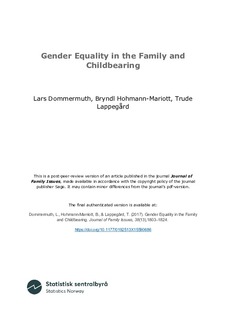| dc.contributor.author | Dommermuth, Lars | |
| dc.contributor.author | Hohmann-Marriott, Bryndl | |
| dc.contributor.author | Lappegård, Trude | |
| dc.coverage.spatial | Norge / Norway | nb_NO |
| dc.date.accessioned | 2019-03-01T14:49:57Z | |
| dc.date.available | 2019-03-01T14:49:57Z | |
| dc.date.issued | 2015-06-15 | |
| dc.identifier.citation | Dommermuth, L., Hohmann-Marriott, B., & Lappegård, T. (2017). Gender equality in the family and childbearing. Journal of Family Issues, 38(13), 1803–1824. | nb_NO |
| dc.identifier.issn | 1552-5481 | |
| dc.identifier.uri | http://hdl.handle.net/11250/2588339 | |
| dc.description | | nb_NO |
| dc.description.abstract | Gender equality and equity in the division of household labor may be associated with couples’ transitions to first, second, and third births. Our comprehensive analysis includes the division of housework and child care as well as the perception of whether this division is fair and satisfactory. We use a unique data set combining the Norwegian Generations and Gender Survey (2007) with information on childbirths within 3 years after the interview from the population register. We found that an unequal division of housework is associated with a decreased chance of first and subsequent births. Child care is most relevant when the respondent is satisfied with the division, as one-child couples where the respondent is less satisfied with the division of child care are less likely to have a second child. Our findings suggest that, even in a high-equity context such as Norway, equality and equity in the household are also important for childbearing. | nb_NO |
| dc.language.iso | eng | nb_NO |
| dc.publisher | Sage Publications | nb_NO |
| dc.rights | Attribution-NonCommercial-NoDerivatives 4.0 Internasjonal | * |
| dc.rights.uri | http://creativecommons.org/licenses/by-nc-nd/4.0/deed.no | * |
| dc.subject | Childbearing | nb_NO |
| dc.subject | Gender equality | nb_NO |
| dc.subject | Fertility | nb_NO |
| dc.subject | Familier | nb_NO |
| dc.subject | Fruktbarhet | nb_NO |
| dc.subject | Likestilling | nb_NO |
| dc.subject | Kjønnsforskjeller | nb_NO |
| dc.subject | Husarbeid | nb_NO |
| dc.title | Gender equality in the family and childbearing | nb_NO |
| dc.type | Journal article | nb_NO |
| dc.type | Peer reviewed | nb_NO |
| dc.description.version | acceptedVersion | nb_NO |
| dc.rights.holder | ©Sage Publications. Users who receive access to an article through a repository are reminded that the article is protected by copyright. Users may download and save a local copy of an article accessed in an institutional repository for the user's personal reference. | nb_NO |
| dc.subject.nsi | VDP::Samfunnsvitenskap: 200::Sosiologi: 220 | nb_NO |
| dc.source.pagenumber | 1803-1824 | nb_NO |
| dc.source.volume | 38 | nb_NO |
| dc.source.journal | Journal of Family Issues | nb_NO |
| dc.source.issue | 13 | nb_NO |
| dc.identifier.doi | https://doi.org/10.1177/0192513X15590686 | |
| dc.relation.project | This study is part of the research project Family Dynamics, Fertility Choices and Family Policy (FAMDYN), funded by the Research Council of Norway (Project no. 202442/S20). The longitudinal data were provided through the ACCESS Life Course Infrastructure Project funded by the Research Council of Norway (Grant no. 195403) and NOVA | nb_NO |

